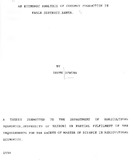| dc.description.abstract | This study, conducted in Kikoneni location of Kwale
district, was prompted by Kenya's net importation of vegetable
oil, whereby it spends almost US$ 80 million or Ksh 4.5 billion
annually to purchase 200,000 metric tons of vegetable oil (80%
of its domestic demand). Resulting in a significant drain on the
scarce foreign exchange reserves, thereby an emphasis by the
government to promote local oilcrops production to levels of
self-sufficiency (Development plan, 1989-1993). Coconut, one of
the local oilcrops offers the greatest potential in contributing
to increased vegetable oil production, yet its production has
been declining over the years.
The objective of the study was to analyze the existing
coconut-based farming systems in the study area, identify farm
level problems facing coconut farmers, suggest ways of easing the
problems to improve production and determine the relative
profitability of coconut-based intercrops. Farming systems
analyses and gross margin analyses methodologies were used.
The study revealed that, coconut producers used none or
minimal levels of recommended coconut inputs resulting in low
yields of 6-7 tons/ha compared to a potential of 17.5 tons/ha.
Credit availability was a constraining factor for the purchase
of recommended coconut inputs as reported by 90% of the farmers.
Other constraints included, poor price structure for both nuts
and copra which was as low as 35cts-ksh 3.00 and ksh 4.~0-Ksh
20.00 per kg respectively. Lack of an organized marketing system
and timely market information further compounded the problem as
reported by 70% of those interviewed. Insect damage caused by the
rhinoceros beetle was observed by 70% of' the respondents and
-ixresulted
in yield losses, consequently low coconut production.
Gross margin analyses revealed low returns for monocropped
coconut holdings compared to coconut-based crop mixtures. The
former had gross margins per acre of ksh 208, ksh 1,687 and ksh
842 for small, medium and aggregate farm model respectively
compared to ksh 12,655, ksh 2,319 and ksh 12,655 for the most
profitable coconut-based crop enterprises in the same farm model
categories.
The study recommended the allocation of funds for extension
purposes for farmers' education and field demonstrations in
coconut crop husbandry management, to improve the yields. The
government should provide market information for coconut products
to allow forces of supply and demand set the price. This study
gives as a guideline the price of copra to be 10-25% of the
break-even price, determined in the study as Ksh 24.60 per Kg.
Prioritization of coconut production is recommended by improving
farmers' accessibility to credit for coconut farm investment
through provision of medium term loans by local financial
institutions, improvement of input distribution, development of
rural access roads and general infrastructure. Research be
undertaken on rhinoceros beetle control, appropriate coconut
intercrop mixtures and associated agronomic technologies with
adequate and consistent information dissemination to farmers.
Other studies should come up with the effect of the importation
of coconut products, copra and oil, on the coconut industry and
determine modalities of credit provision for coconut investment. | en |

